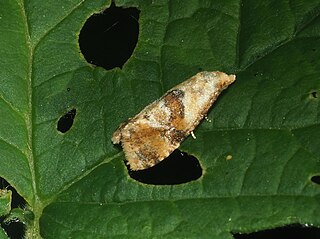Pachygeneia is a genus of moth in the family Gelechiidae. It contains the species Pachygeneia clitellaria, which is found in Brazil (Amazonas) and Peru.

Cochylichroa atricapitana, the black-headed conch, is a moth of the family Tortricidae. It is found in China (Xinjiang) and the eastern Palearctic and most of Europe.
Netechma consimilis is a species of moth of the family Tortricidae. It is found in Ecuador.
Inape saetiphora is a species of moth of the family Tortricidae which is endemic to Peru.
Henricus montuosus is a species of moth of the family Tortricidae. It is found in Costa Rica.

Phalonidia aetheria is a species of moth of the family Tortricidae, the subfamily Tortricinae, and the tribe Cochylini. It is found in Brazil, in the states of São Paulo, Santa Catarina and Goias.

Phalonidia lavana, or Platphalonidia lavana, is a species of moth of the family Tortricidae, the subfamily Tortricinae, and the tribe Cochylini. It has a terrestrial habitat and is found throughout North America. It does not have a Global Conservation Status Rank.
Phalonidia remissa is a species of moth of the family Tortricidae. It is found on Cuba.
Phalonidia decrepita is a species of moth of the family Tortricidae. It is found in Goiás, Brazil.
Phalonidia chlaenites is a species of moth of the family Tortricidae. It is found in Minas Gerais, Brazil.
Phalonidia lacistovalva is a species of moth of the family Tortricidae. It is found in Loja Province, Ecuador.
Phalonidia cermatia is a species of moth of the family Tortricidae. It is found in the Federal District of Brazil.
Phalonidia monocera is a species of moth of the family Tortricidae. It is found in Santa Catarina, Brazil.
Omiostola delta is a species of moth of the family Tortricidae. It is found in Carchi Province, Ecuador.
Rutilograptis cornesi is a species of moth of the family Tortricidae. It is found in Nigeria.
Anacampsis lithodelta is a moth of the family Gelechiidae. It was described by Edward Meyrick in 1922. It is found in Peru.
Stenoma hopfferi is a moth of the family Depressariidae. It is found in Brazil (Pará) and the Guianas.
Stenoma amphitera is a moth in the family Depressariidae. It was described by Edward Meyrick in 1913. It is found in Peru.

Pammene argyrana is a species of moth belonging to the family Tortricidae.

Phalonidia udana, or the loosestrife conch, is a European species of moth of the family Tortricidae, the subfamily Tortricinae, and the tribe Cochylini. It is widely distributed in the North Palaearctic but appears to be largely rare or missing in Central Europe. Previously, it was classified under the Phalonidia manniana taxon, but a recent effort to barcode all North European Lepidoptera revealed that P. udana and P. mannania are two distinct species.




